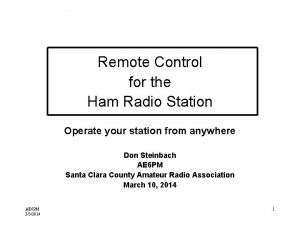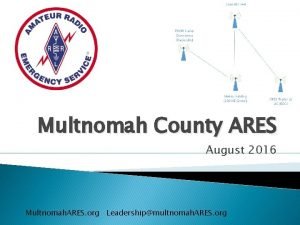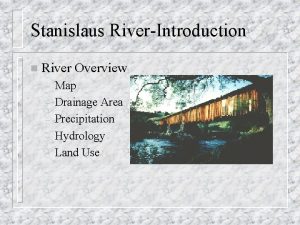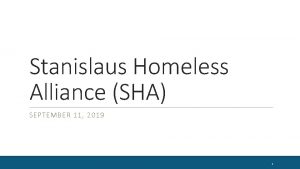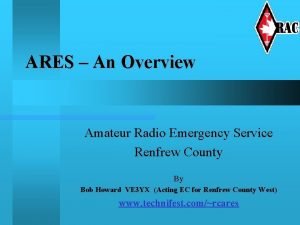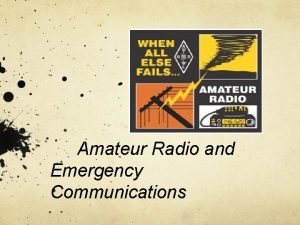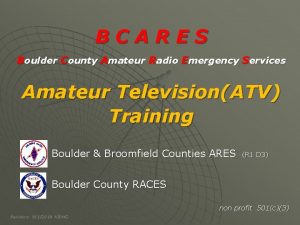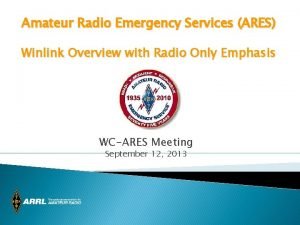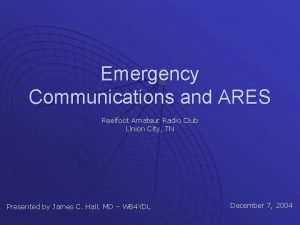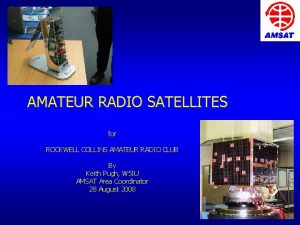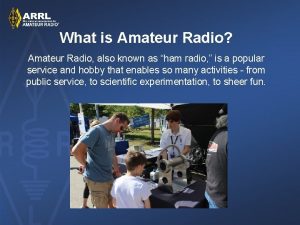Stanislaus County Amateur Radio Emergency Service ARES Response



















- Slides: 19

Stanislaus County Amateur Radio Emergency Service ARES Response Guide 2019

This guide is intended to guide Stanislaus County ARES members during a time of activation. This guide should provide all members with step by step activation instructions. 2019

Table Of Contents ARES Officers……………………. 1 Activation Protocol………………… 2 Call out procedure…………………. 3 Activation Protocol (ARES Room)…………… 5 Activation Protocol (Field Teams)…………… 6 Dress Code………………………. . 7 ARES ICS forms to be used…………… 8 Emergency Coordinator Position……………. 9 ARES Room (Position One)…………. . 10 ARES Room (Position Two)…………. . 11 ARES Room (Position Three)…………………. . 12 Demobilization plan………………. 13 SCARES Frequency Plan……………. 14 SCARES Monitored Frequencies……………. . 15 Packet Nodes……………………. 16 2019

Stanislaus County ARES Officers Stanislaus County Emergency Coordinator: Pat Mandas, KG 6 JXZ Stanislaus County Asst. Emergency Coordinator: Lucian Thomas, KF 6 NPG Stanislaus County Asst. Emergency Coordinator: Technology Officer: Patrick Dunbar, KG 6 AZZ Stanislaus County Asst. Emergency Coordinator: Administration Officer, James “Wally” Walsh, KK 6 CPN Stanislaus County Asst. Emergency Coordinator: Training Officer: John Otte, K 6 JRO Stanislaus County Asst. Emergency Coordinator: PIO, Bill Danforth, AE 6 J San Joaquin Valley District Emergency Coordinator: Paul Owen, W 6 UHF San Joaquin Valley Section Emergency Coordinator: Ed Hanna, KF 6 FIR San Joaquin Valley Section Manager: Dan Pruitt, AE 6 SX Fire Warden, Assistant Director of Emergency Services ARES Officers can be contacted through the ARES Website Stanislaus County ARES Website www. stanares. org 2019 Page 1

Activation Protocol The activation of Stanislaus County ARES will be executed in this order. ARES activation will come from the EOC management staff. The EOC will contact ARES officers in descending order as follows. ARES officers that receive activation orders will immediately contact the down line who will begin activating ARES members. No ARES member may take it upon themselves to activate or participate in an activation without authorization from the ARES officer. EOC Management Staff will activate ARES by contacting the following and proceeding down the list until at least 2 officers have been contacted. ARES Activation contacts in descending order Lucian Thomas kf 6 npg@aol. com 209 -471 -0103 Ed Hanna ed@kf 6 fir. net 209 -345 -9942 Paul Owen w 6 uhf@aol. com 209 -531 -3322 Joe Park wb 6 agr@yahoo. com 209 -765 -5155 Pat Mandas kg 6 jxz@charter. net 949 -466 -3413 Derrill Coffman hamradio@mlode. com 209 -770 -4409 Telephone Number ARES Room Emergency Operations Center 209 -552 -3885 Page 2 EOC Main Number 209 -552 -3600 2019

CREDENTIALS Activation/ Call Out Procedure ARES Members Activation will be done by Activation Contacts: KG 6 JXZ, WB 6 AGR, W 7 LTM, KF 6 FIR, W 6 UHF, KF 6 NPG Deployed ARES members must possess valid County issued ARES ID Card to work at locations such as, Hospitals, Emergency Operations Centers, Red Cross etc. These ID cards have the county logo. ARES members that do not possess a valid County ID card, will be assigned to work directly under a credentialed member or to an alternate location. Deployment is at the discretion of the ARES officers and in particular the ARES Operations officer in charge of the event or deployment. Page 3 2019

Activation/ Call Out Procedure ARES Members Activation will be done by Activation Contacts or ARES Officers: The following will be used by ARES Officers to activate ARES personnel: 1. Repeater Notification 2. Electronic messaging via email & text to your smart phone 3. County Reverse 911 4. Telephone call via the Telephone Tree Page 4 2019

Activation Protocol ARES Members Staffing & Deployment ARES Room The ARES room should be staffed as soon as physically possible. First *RO arrival at ARES room: Assume EC position Monitor and Use SARA Repeater 145. 390 Clear repeater of unnecessary traffic Prepare ICS Forms to be utilized for assignments STOP! Go no further, manage these items at this point, wait for assistance to arrive. Second *RO arrives at ARES room: Assume Scribe/Runner position Take direction from acting EC STOP! Refrain from operating equipment until instructed by EC. Third *RO arrives at ARES room: Check in with EC for assignment (Operate secondary communications as requested by EC, VHF/UHF, Packet, APRS etc. ) Acting EC will hand off to County EC upon arrival *RO = Radio Operator Page 5 2019

Activation Protocol ARES Members Staffing & Deployment Field Teams All field team members should deploy in teams of 2 when possible. All team members will report to the EOC once activated. Team members will be deployed from the EOC unless otherwise instructed. All team members will be deployed by the Emergency Coordinator, or officer in charge. No ARES member will ever deploy themselves to a disaster. We only deploy at the request of the Stanislaus County Fire Warden. Page 6 2019

Activation Protocol ARES Members Staffing & Deployment Dress Code It is of the utmost importance that all ARES members always portray a professional appearance and behavior. Professional behavior needs to be exhibited at all times during an activation as well as day to day. Please conduct yourself professionally in person, and on the radio to insure all ARES members maintain the highest level of integrity. All ARES members are expected to maintain good hygiene at all times, since most likely we will be working in cramped quarters or with public officials. The dress code for activations is a simple acceptable presentation, please wear pants that do not contain holes or stains, jeans ok, as long as they are in good condition, again no stains or holes. Collared shirts are required during a deployment, please no t-shirts or shirts that have stains or holes. ARES name badges are required at every location during an activation. ARES officers reserve the right to send you home if you are non-compliant with the above protocol. Page 7 2019

ICS Forms for ARES ICS 201: Initial Response/Transfer of Command (designed to be a field response form) ICS 202: Objectives (includes weather, safety message, and boxes for attachments) ICS 203: ICS Organization (lists all supervisors, leaders, directors, chiefs, commanders, etc. ) ICS 204: Branches, Divisions/Groups (specific assignments, mission, frequencies, etc. for each) ICS 205: Radio Communications Plan (consider a 205 A or similar form for phone lists & other info) ICS 206: Medical Plan (for the workers/responders) ICS 207: Organization Chart (should mirror the 203) ICS 209: Incident Status Summary (great for IC's, PIO's, etc to serve as an update) ICS 211: Incident Check-In Form ICS 213: General Message Form ICS 214: Unit Log (activity log for everyone for the Operational Period) ICS 215: Operational Planning Worksheet (focuses on work assignments and resources needed) ICS 215 A: Safety Hazards/Mitigation (for each of the work assignments listed on the 215) ICS 221: Demobilization Check-Out Form Page 8 2019

ARES Room Emergency Coordinator Position (Standard Operating Procedures) EC Activation Checklist: 1. 2. 3. 4. 5. Open ARES Room, Turn on all lights and Power supplies Monitor 2 Meter Repeaters Meet with Incident Command for Immediate needs Assess staff and equipment needs Prepare necessary ICS forms 1. ICS-214 2. ICS-205 3. ICS-201 6. Assign Scribe 7. Assign ARES Room staff to tasks or positions 8. Assign field teams to locations as they check in 9. Contact Webmaster, Set Activation Status on Website 10. Contact Weather Operator to stand by for reporting Page 9 2019

ARES Room Position One (Standard Operating Procedures) Set up equipment: Using the Kenwood D-700 APRS Computer and TNC Monitor All Local Area APRS Activity on APRS computer Establish radio communications with Weather Operator on SARA Doubletree repeater Monitor SARA repeaters for traffic handling Action Take regular weather reports from Weather Operator via Secondary repeater (Formerly Doubletree) Assist EC as needed Monitor APRS Feeds Handle VHF/UHF Traffic as needed Page 10 2019

ARES Room Position Two (Standard Operating Procedures) Set up equipment: Using the Yaesu FT-1500 Using AZZ Packet & Winlink Computer and TNC Using Kenwood D 700 for VHF/UHF communications Monitor UHF/VHF Local Repeaters AZZ Packet or Winlink Action Assist EC as needed Handle VHF/UHF Traffic as needed Establish packet radio communications with deployed ham stations Establish messaging outside of the county via Winlink to other ARES groups Monitor SARA repeaters for traffic handling Page 11 2019

ARES Room Position Three (Standard Operating Procedures) Set up equipment: Using the Icom 756 -Pro III Set up the 2 nd Pro III radio for WEFAX Monitor All Local HF Traffic in and around county MARS Stations Monitor SARA repeaters for traffic handling Monitor 11 Meter Traffic Action Make contact in and out of the county during an incident Assist EC as needed *Make contact with MARS Stations outside of county Handle VHF/UHF Traffic as needed Handle 11 meter traffic from public *Only MARS certified RO’s. Page 12 2019

ARES Activation Demobilization Directed by EOC/NET Control All ARES members should check in regularly Net control will issue a stand down order when appropriate Once the ok is given to stand down, you may secure your location and depart. ARES members must report to the EOC at the end of their deployment, unless otherwise specified by NET Control Your demobilization should be logged in your ICS-214 form as well as ICS-221 Demobilization sheet. Page 13 2019

2019 Page 14

ARES Frequencies Monitored during an Emergency Band Frequency 2 Meters 145. 390 6 Meters PL 136. 5 220 MHZ SARA Rep 146. 520 Nat’L Simp 147. 540 Local Simp 51. 80 136. 5 52. 525 440 MHZ Channel 440. 225 SARA Rep Nat’L Simp 136. 5 SARA Rep 446. 000 Nat’L Simp 222. 350 Nat’L Simp 224. 140 136. 5 SARA Rep 10 Meters 28. 495 20 Meters 14. 345 40 Meters 7. 295 80 Meters 3. 995 Page 15 MURS 151. 940 CH. 3 CB 26. 985 CH. 3 FRS 462. 6125 CH. 3 GMRS 462. 600 CH. 3 462. 625 136. 5 ARES Rep 2019

2019 Page 16 Packet Nodes
 Stanislaus county hazardous materials division
Stanislaus county hazardous materials division Stanislaus county 4 h
Stanislaus county 4 h Ham radio remote operation
Ham radio remote operation Tonga hf radio
Tonga hf radio Bcares
Bcares Linkcalc ubnt
Linkcalc ubnt Amateur radio digital communications
Amateur radio digital communications Chelmsford amateur radio society
Chelmsford amateur radio society Chelmsford amateur radio society
Chelmsford amateur radio society Chelmsford amateur radio society
Chelmsford amateur radio society Bbhn
Bbhn Monroe county ares
Monroe county ares Multnomah county ares
Multnomah county ares Stanislaus absn
Stanislaus absn Stanislaus river map
Stanislaus river map Stanislaus homeless alliance
Stanislaus homeless alliance Csu stanislaus msw program
Csu stanislaus msw program Marin emergency radio authority
Marin emergency radio authority Rencana tanggap darurat
Rencana tanggap darurat Erg guide 111
Erg guide 111


